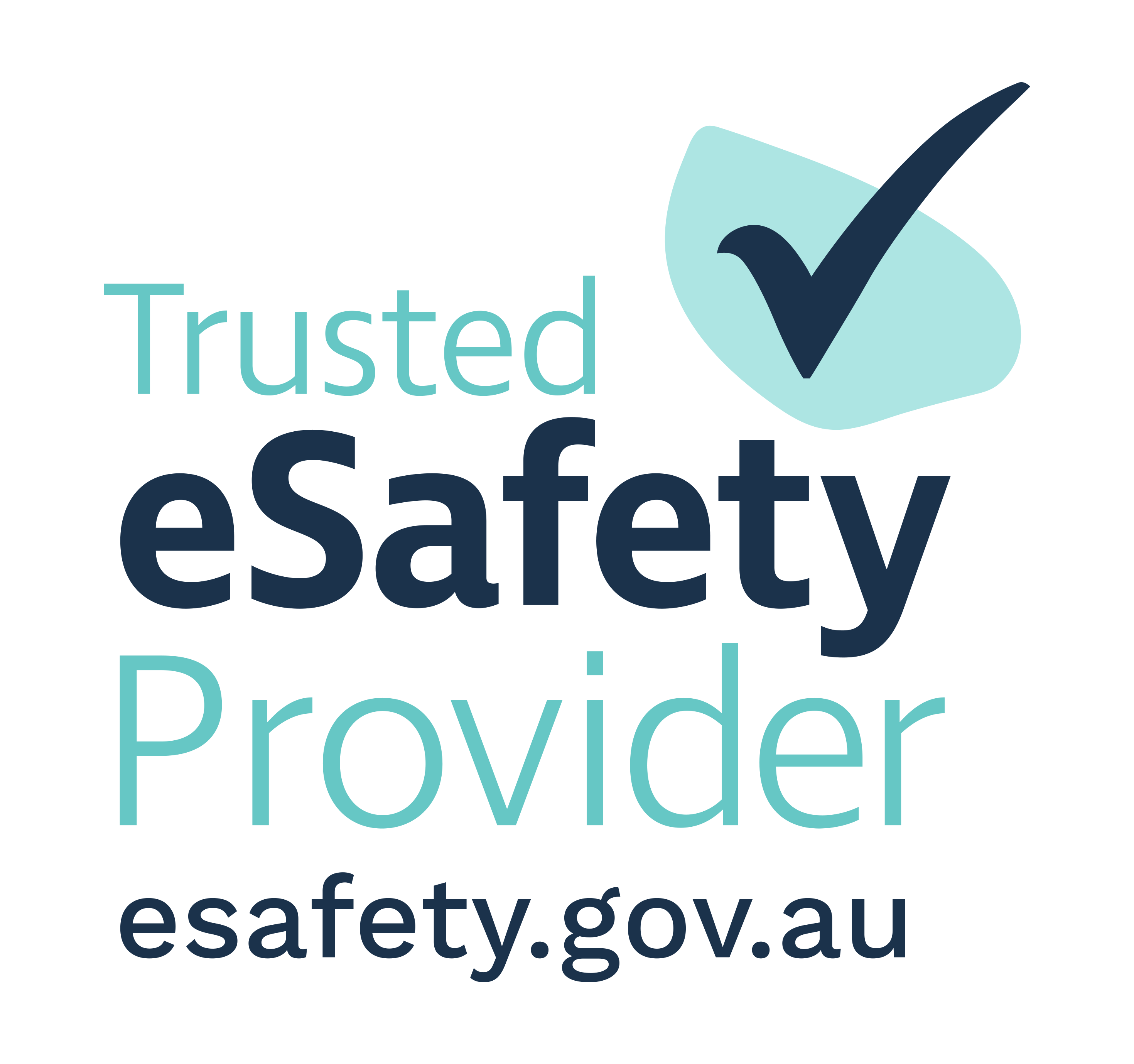eSmart
Keep your students smart, safe and responsible online with eSmart – Australia’s trusted provider of online safety education. Free to all schools in Australia.

Digital technology is part of everyday life for children.
By developing digital literacy during their formative years, students can harness opportunities, overcome challenges and develop strong foundations to thrive online.
We’ve developed modules to help your students earn their Digital Licence. They’ll gain the knowledge, attitudes and beliefs to become positive digital citizens.
eSmart Digital Licence+ is free to access for Australian schools, and is also available in New Zealand, Indonesia and the Philippines.
Since 2021, over 122,000 students have participated in Digital Licence+.
Digital Licence+ is funded by the Australian Government and aligned with the national curriculum. That means it’s up-to-date, evidence-based and developed to be at the highest standard. You’ll find it’s also easy to use and highly engaging for your students.

Funded by the Australian Government, eSmart Digital Licence+ is a curriculum-aligned, interactive online learning tool that helps build digital intelligence in students in Years 4-6.
eSmart Digital Licence+ is an interactive online learning tool that helps build digital intelligence for students aged 10-14.
Digital Licence+ is free to access for Australian schools and is also available in New Zealand, Indonesia and the Philippines.
Students are engaged with learning materials, relatable scenarios and guided reflections of their own experiences with technology to support them in building their digital intelligence. By completing each milestone, students earn badges towards the attainment of their Digital Licence.
The Alannah & Madeline Foundation partnered with the DQ Institute to align Digital Licence+ with the DQ global standard to deliver engaging, high-quality, evidence-based learning experiences for users.
Digital Intelligence – or DQ – is a comprehensive set of skills needed for young people to thrive in the digital age. The DQ framework developed by the DQ Institute is the global standard related to digital literacy, digital skills, and digital readiness as approved by the IEEE Standards Board (IEEE 3527.1™).
We’ve developed Digital Licence+ to suit students aged 10 to 14. Some modules will be more suited to younger students and some to older students. An overview of each module is below.
If you have questions about teaching Digital Licence+, please contact the eSmart help desk.
What it covers:
This module supports students to understand the importance of balancing their technology use with other parts of their lives. It’s about knowing how to achieve balance and self-regulate.
What students learn:
Balance in technology use: Balancing our technology use is important for our health, wellbeing and lifestyle, and understanding that it looks different for everyone.
Impacts of imbalance: How we decide to use technology is important because that choice will influence relationships, physical health, mental wellbeing, sleep, school and play.
The role of self-regulation: Self-regulation gives us a vital set of skills that we can use to balance technology use in our lives. Self-regulation means you think about how you want to use technology in your life and decide on strategies that can help you to use technology in a balanced way.
What it covers:
Students learn about many types of online risks, such as cyberbullying, and how leading with kindness can create a more positive community. Students will also learn strategies to deal with cyber risks, and how to be an upstander to help others.
What students learn:
Behavioural cyber risk awareness: If we don’t treat each other well, then there is a risk of harm. In the online world, many antisocial behaviours present a risk of harm to others, including cyberbullying, harassment, exclusion, cyberstalking, impersonation, outing and manipulating images.
Upstanding and positive online cultures: The way we behave online creates the culture we experience online. As a collective, the more kindness we give, the more we create a positive online experience for everyone.
Dealing with antisocial behaviours: When we encounter antisocial behaviour, we understand how to cope with it, using cognitive, communication and technical skills. Whilst relationships can be a vehicle for harm, trusted relationships are where we can seek help for issues that we, and others, encounter online.
What it covers:
This module helps students understand the attributes or ‘red flags’ of a cyber threat (particularly phishing scams) and know how to identify, deal with, report and remain vigilant to cyber threats.
What students learn:
Identifying cyber threats: The internet is used by people to try and access the information of others.
Protecting against phishing: Phishing scams have common attributes or 'red flags' that we can identify, and there are things we can do to protect ourselves if we come across these red flags.
Responding when scammed: The impacts of cyber threats are serious, and it is hard to know what to do if you have been scammed.
What it covers:
What is empathy? Why is it important? In this module, students learn about the challenge of online disinhibition and how they can demonstrate empathy online.
What students learn:
Thinking empathetically: Sometimes it's easy to do or say things online that might not be said or done in person (face-to-face). We need to think empathetically to understand others.
Behaving empathetically: We can demonstrate empathy through perspective-taking.
Building positive online cultures: The things that we do and say online have consequences and contribute to online cultures.
What it covers:
What’s the connection between how technology is designed and our ability to achieve a balanced use of that technology? We can apply strategies to overcome the challenges presented by the attention economy.
What students learn:
Countering persuasive design: Technology is designed to hold our attention in various ways, which makes it hard to achieve a healthy and balanced use of technology.
Strategies for achieving balance: We can each take control and use technology in ways that are healthy and balanced – using knowledge and strategies.
The role of self-regulation: Self-regulation gives us a vital set of skills that we can use to achieve a balanced and healthy use of technology. Self-regulation is when you can set goals for yourself, put in place strategies to achieve those goals, think about how well your strategies are working, and adjust them if they do not work.
What it covers:
What is hateful or discriminatory content? What is image-based abuse? And how can we use kindness to deal with harmful content?
What students learn:
Content cyber risk awareness: People and organisations create digital content that can be both beneficial and harmful. Some user-generated content can be damaging, such as racist, discriminatory content/ images, and image-based abuse.
Mitigating content cyber risks: In our daily lives, we all have a part to play in reducing harmful content through our own self-management, reporting content as we come across it. When creating content, we need to ensure it is NOT unkind.
The role of kindness: Kindness is an intentional prosocial action that, above all, promotes positive outcomes for others.
What it covers:
How can we practice good network cyber security by exploring the Internet of Things? This module explores how the Internet of Things works, including the benefits and risks it presents, and how to stay safe when using devices.
What students learn:
Network technology concepts: The Internet of Things (IoT) is a complex network of connected technologies. The real benefits of the Internet of Things are that everyday devices are connected to each other and the Internet, but that is also a key risk.
IoT risks: Preventing your exposure to IoT cyber threats requires you to identify the weaknesses within a network.
The role of vigilance: Protecting yourself from cyber threats involves managing your own use of technology.
What it covers:
Understanding the connections between our experience with technology, emotions, behaviours and values is important. By developing strategies to regulate our emotions when using technology, we can act in a way that best represents our values.
What students learn:
The link between emotions and behaviours: Technology can affect our moods. Our emotional responses to technology can shape our behaviours.
Prosocial personal values: How we behave online is seen as a reflection of what we stand for. It is important to ensure that our online behaviour is consistent with our personal values, and that these values are prosocial.
Emotional regulation: Emotional self-regulation involves understanding our emotions and managing how we react to the situations we find ourselves in online. The better our emotional self-regulation is, the more likely it is that we will respond in a way that reflects our values.
The following resources are available within the eSmart Digital Licence+ and will assist and support you to deliver the teachings available with each module in your classroom. You can access these resources once you are logged into Digital Licence+. If you require any assistance in accessing these resources, please reach out to your eSmart Advisor.
Contact us to learn how your school can get involved.

Keep your students smart, safe and responsible online with eSmart – Australia’s trusted provider of online safety education. Free to all schools in Australia.

Online and in-person events for teachers, parents and carers.

A fun, gamified platform empowering students to navigate the media landscape. Free for all Australian schools!


